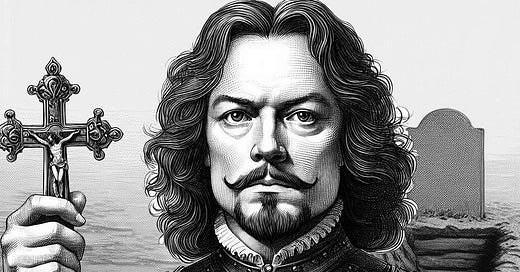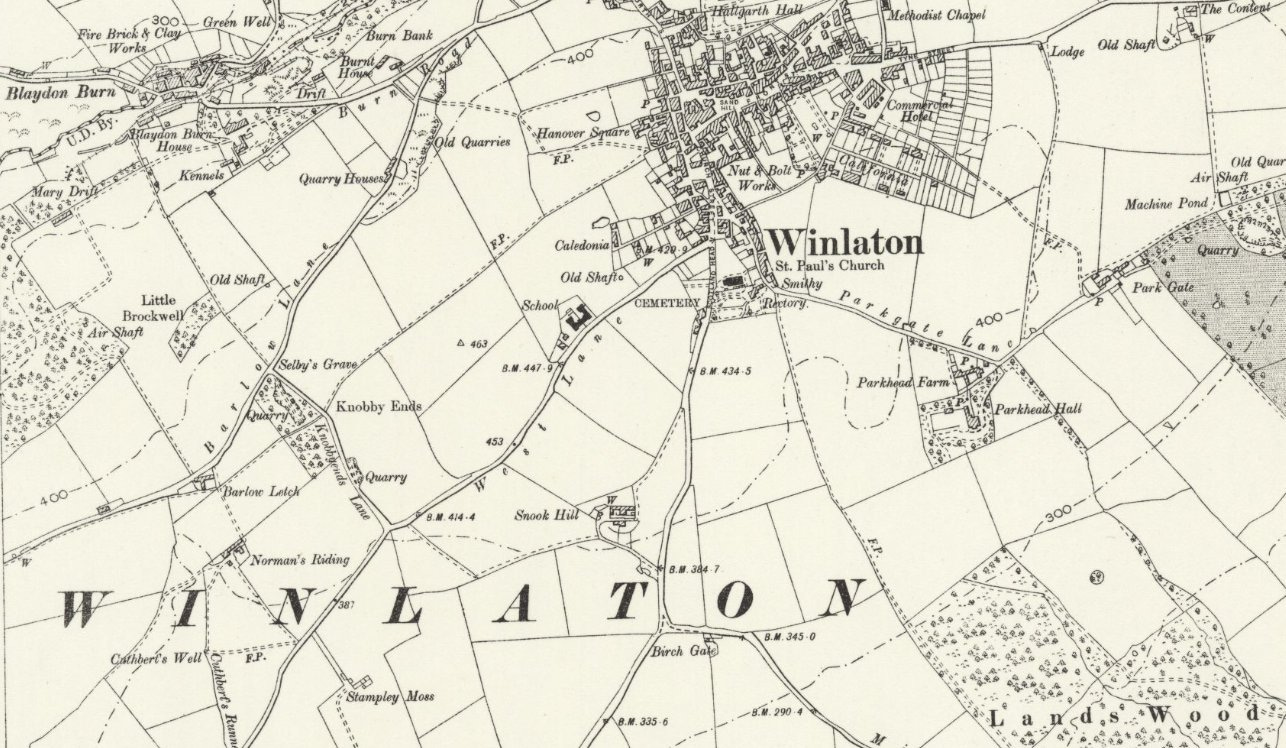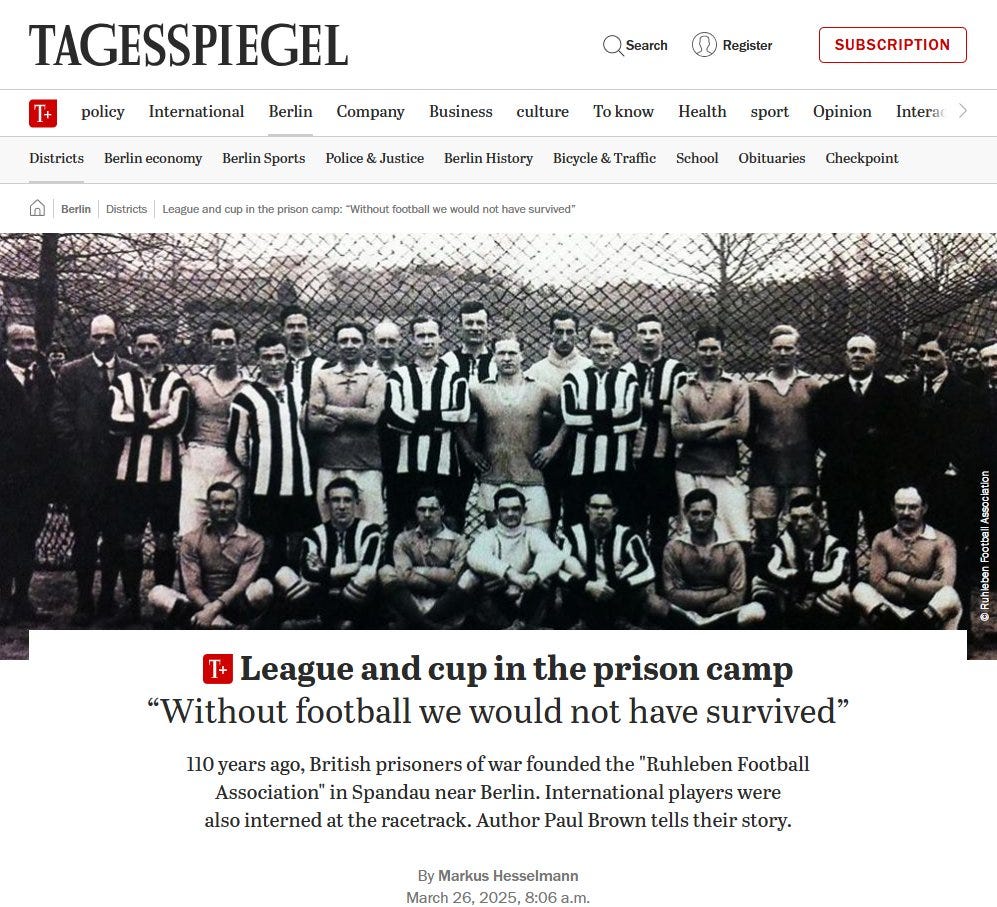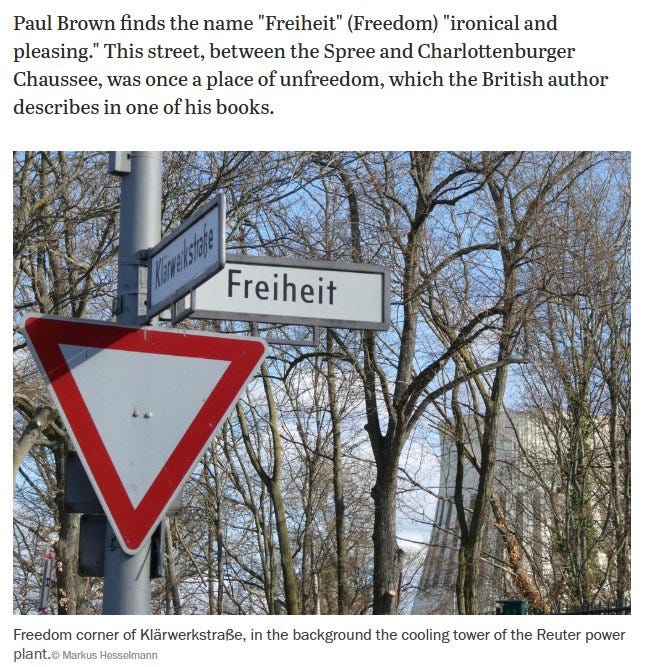Oliver Cromwell and the Vampire's Grave
The Lord Protector and a strange burial; PLUS True crime book, New Beatles find, Chernobyl FC, Ruhleben article
On 15 July 1650, a thunderous noise rose from the Derwent Valley towards the hilltop valley of Winlaton, in the North East of England. This rumble of hooves, creaking of wagons and thumping march of feet signalled the approach of a huge army. And so it came, through the oak and birch of Lands Wood, up the ancient burial route known as the Black Path. The cavalry with their broadswords and pistols and lobster pot helmets; the infantry with their pikes and muskets and marching drums; the artillery with their cannons and mortars and crates of iron shot.
This was the New Model Army, led by Lord General Oliver Cromwell. It comprised around 16,000 men, known as the Roundheads, many of them veterans of the English Civil Wars, in which they had fought for the Parliamentarians against King Charles I and the Royalists. Following the execution of Charles I in the previous year, England became a republic. However, Scotland declared Charles’ son, Charles II, the King of Britain, and the Scots began to assemble an army to support him. So Oliver’s Army was on their way to Scotland to shut down Charles Jr’s claim to sovereignty via a full-scale invasion.
There was a story from my childhood in Winlaton about a local teacher who found a Roundhead sword in the stream that runs alongside the Black Path. As kids, Lands Wood was our playground, and I would always keep an eye out for my own piece of Oliver Cromwell’s treasure. Today, I can’t find any reliable reference to the story of the sword being true, although there are references to cannon and musket balls being found along the route. Certainly, the army did pass through Winlaton, and Cromwell stayed at Stella House, on the way to fording the River Tyne at Newburn.1 Today, there is a Cromwell Avenue in Winlaton and a Cromwell Ford Way in Stella. But Cromwell’s activities left a long-forgotten and much stranger legacy in Winlaton.
Cromwell led the Roundheads to victory over the Scots at the Battle of Dunbar, and subsequently became Lord Protector and head of state of England, Scotland and the rest of the Commonwealth. Following Cromwell’s death in 1658, the protectorate was abolished, and the monarchy was restored, with Charles II finally crowned. In one of the first acts of the Restoration, Charles II pardoned all past treason against the monarchy, excluding those involved in the trial and execution of Charles I. Many of those regicides were hanged, drawn and quartered. Cromwell’s body was exhumed and posthumously hanged and beheaded. Other conspirators were hunted across the country.
In the spring of 1660, an “unknown gentleman” came to live in Winlaton. He kept to himself and might not have even revealed his name. However, he was seen to be very inquisitive about news of the Reformation, and particularly about whether Charles II would pardon the regicides. After word reached Winlaton that the monarch would not pardon those responsible for his father’s death, this unknown gentleman went into Lands Wood, threw a rope over a tree, and hanged himself.
Not far from the wood, where Cromwell’s army had marched, was a crossroads known as Knobby Lanes End, named for the Knobby (or Nobby) stone quarry. Tradition dictated that suicides could not be buried in consecrated ground, and must instead be buried at midnight at a crossroads. So, the unknown gentleman was cut down from his tree and buried at Knobby Lanes End. In a final humiliation, to prevent this man from rising from the dead and leaving his grave, a stake was driven through his heart. This vampiric touch pre-dated Bram Stoker’s Dracula by more than 200 years.
The so-called vampire’s grave was marked with a cairn, and initially with the stake (or “stob”). It became a local landmark, and for hundreds of years, passers-by would throw three stones at the cairn that marked the grave — a superstition supposedly designed to help a spirit pass to the afterlife.
The grave is marked on old maps as “Selby’s Grave”. There’s no clear evidence that the “unknown gentleman”, some say vampire, was called Selby. There were several Selbys in Winlaton around this time, including some prominent landowners. Sir William Selby, owner of the Whitehouse Park Estate (now Axwell Park), died in 1649. His son, also William, had been killed in a duel in 1636, after which Sir William seems to have decided to dispose of his properties and business interests. Sir George Selby and Mr Charles Selby died in 1668, and Thomas Selby died in 1670. There is no mention in the parish records of a Selby dying in 1660, or of any suicide.
There are a couple of interesting points worth noting. First, the superstitions surrounding the man’s burial were not unusual. Just a year before Cromwell’s army marched through Winlaton, magistrates in nearby Newcastle appointed a Scottish witchfinder, who was probably named John Kincaid, to eradicate a supposed scourge of witchcraft. Kincaid identified 30 witches in Newcastle, and 27 of them were hanged in August 1650 on the Town Moor at the site of what is now Newcastle United’s St James’ Park. Kincaid then travelled south of the Tyne, likely to Winlaton, where he identified another ten witches before being chased back to Scotland, where he himself was hanged.
Second, the Whitehouse, home of the Selbys, was thought to be haunted. Around the beginning of the 1600s, its then occupants, the Ogle family, were terrorised by visions of Jane Watson, a local healer. Two children claimed Watson visited them in the night, gave them an apple and then disappeared in a “flash of fire.” A servant heard the children screaming, ran to their room, and said she saw Watson hiding under the children’s bed. The master of the house, John Ogle, thrust his sword under the bed and heard a terrible scream. But all he found was a half-eaten apple.
It seems likely that the gentleman who was buried in “Selby’s Grave” was a prominent Parliamentarian who was involved in the death of Charles I and was associated with Oliver Cromwell. Had he marched with the army through the village in 1650? Exactly who he was and why he ended up in Winlaton remains a mystery. The cairn no longer exists, but if you head along Knobby Ends Lane from Winlaton towards Barlow you might be passing over a vampire’s grave.◆
This is the latest in a series of posts about the weird world of Winlaton — a historic and strange village in the North East of England. (It’s pronounced “Win-lay-ton”.) You can find previous posts in this series here.
If you’re not already a subscriber, sign up for free to receive new posts every month. And if you think you know someone who might like to read Singular Discoveries, please share this with them and encourage them to join us!
Recommended
Book: A Thread of Violence by Mark O’Connell (2023)
I was struck by this book’s subtitle, A Story of Truth, Invention and Murder. The subtitle of my book The Rocketbelt Caper is A True Story of Invention, Obsession and Murder. But that’s about where the similarities end. A Thread of Violence is about Malcolm Macarthur, a wannabe bank robber who ended up killing two people and hiding out at the home of his friend, the Irish Attorney General, in a chain of events that could have brought down the Irish government. Mark O’Connell tracks down the highly unusual Macarthur and attempts to determine what led this well-connected heir to become a murderer, while navigating the complex relationship between writer and subject. What emerges is a fascinating portrait of a strange criminal, a darkly comic and gripping read. You can find A Thread of Violence on the Singular Discoveries Amazon bookshelf.*
Article: A lost Beatles demo tape turned up in Vancouver. It sounds like a revolution by Jonathan Dekel (Globe and Mail)
I’m a sucker for Beatles lore, and here’s yet another chapter to add to their seemingly neverending story. An unlabeled reel-to-reel tape has surfaced in Vancouver’s Neptoon Records store, containing a recording of the band’s infamous 1962 Decca audition. Bits of it have turned up on bootlegs and on the official Anthology releases, but this is thought to be an original master. It might even be John Lennon’s personal copy. How did it end up in a Canadian record store? Possibly via Tony Cox, Yoko Ono’s ex-husband. That’s another mystery still to be solved. Oh, by the way, the Beatles failed the audition, and Decca signed Brian Poole and the Tremeloes instead. Read it here. (If you have trouble with that link, read it here.)
From the Archives
Last month saw the 39th anniversary of the Chernobyl disaster, which proved to be an opportunity for some publications to publish Chernobyl-related articles. So here’s my article for FourFourTwo from 2019 (the 33rd anniversary…) about FC Pripyat, the football team that escaped the Chernobyl disaster.
“On the morning of Saturday April 26, 1986, a helicopter landed on a football pitch in northern Ukraine. Players from FC Pripyat were preparing for a big cup semi-final against FC Borodyanka later that afternoon. They watched as men wearing protective suits and carrying radiation detectors clambered out of the helicopter. As the detectors clicked with audible warnings, the men informed the footballers that the match would not be played. There had been an incident at the nearby Vladimir Ilyich Lenin Nuclear Power Plant, also known as Chernobyl.” Read more.
More recently, Chernobyl’s radiation shield was hit by a Russian drone…
Notebook
The German newspaper Tagesspiegel published an article about my book The Ruhleben Football Association, 110 years after the Association was founded behind the barbed wire fences of the WWI prison camp. Like the Chernobyl story, it’s another tale of footballers using the game to survive horrific circumstances. (And it’s very much a movie waiting to be made…)
In the article, author Markus Hesselmann explores the former site of the camp, which, as noted in the book, is now located next to a street named Freiheit, or Freedom. The original article is here, paywalled and in German. You can find an unpaywalled archived version here, which, if you don’t speak German, you can Google translate or just look at the pictures.
Thanks for reading. More next month. Please subscribe and share!
The Old Tyne Bridge between Gateshead and Newcastle - the nearest bridge over the Tyne - was too narrow for the army to use. See my book The Tyne Bridge for more!
*This publication features Amazon affiliate links. If you use them, I may receive a few pennies to help fund the newsletter. See our Amazon bookshelf here.









As a Winlaton Mill resident, I always dream of finding a Cromwellian item along the Black path!